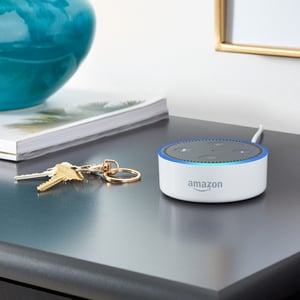 Voice recognition apps have grown in popularity among consumers over the last few years, and the trend continues; for example, voice commands are overtaking typing as the primary way mobile device users conduct online searches.
Voice recognition apps have grown in popularity among consumers over the last few years, and the trend continues; for example, voice commands are overtaking typing as the primary way mobile device users conduct online searches.
It’s easy to understand the appeal of voice products. Being able to perform a function simply by speaking to a bot is much more convenient than having to manually open and navigate an app. However, private consumers aren’t the only ones to benefit from these technologies. Voice technology programs have many potential applications across a wide range of industries.
The examples below demonstrate how professionals and organizations in fields like healthcare, retail, and fintech have leveraged AI programming to develop voice recognition technology that better serve their customers. They’ll help you understand how your company can do the same.
Make Doctors More Efficient
In a survey of medical professionals, approximately 90% of respondents said their facilities were likely to expand their usage of voice solutions.
Why? Efficiency. Several of the facilities that participated in the survey reported that using voice recognition programs allowed their physicians to complete documentation tasks more efficiently, while also reducing the cost of medical transcription services.
This isn’t a minor improvement. The more quickly that physicians and hospital staff can work, the more time they have to devote to patient care. On top of that, the money that hospitals save on transcriptions can instead be used to upgrade their facilities.
Given the results of the survey, it’s highly likely that voice apps will soon play a major role in most average clinics. Developers should take this opportunity to create products that improve on those currently in use.
Improve the Retail Experience
Several companies have already leveraged voice tech to improve the customer experience in both ecommerce and traditional brick-and-mortar retail shopping.
For instance, Domino’s offers an app that allows users to order on-the-go with voice commands. Starbucks lets customers place orders with a virtual barista through a voice activated app.
In brick-and-mortar stores, companies like Theatro are providing customer service representatives with earpieces that allow them to access key information about inventory and product details through voice commands. This allows sales staff to devote more attention to a customer’s needs.
Some brands are even finding unique ways to integrate their products with voice activation technology to improve future retail experiences. For instance, LG has developed a refrigerator that lets owners order groceries simply by speaking to it.
Essentially, this technology makes it much easier for customers to make purchases. Retailers that take advantage of it can expect to enjoy higher sales as a result.
Banking Apps Embrace Innovation
Fintech (financial technology) products have replace typical methods of accessing financial services thanks to the convenience they offer. Banks are making use of these technologies to ensure their customers don’t abandon them for more forward-thinking financial institutions.
For example, Santander Group will now allow its banking customers to open their mobile app and make payments with it using voice activation instead of a password. Barclays is also allowing users to open their app with their voices.
These decisions aren’t merely about giving customers a more convenient experience. Voice is considered more secure than a password: a person can steal your password, but not your voice.
As more banks embrace this option, it’s highly likely that developers will find even more ways to apply this technology to the fintech industry.
Voice skills products are useful in ways most people haven’t even considered yet. Companies that want to better serve their customers while also boosting the overall efficiency of their processes should consider how they can leverage these tools to their benefit.
In the near future, voice recognition may become the primary interface for digital products. Now’s the time to explore how your organization can use it.
This post was contributed by our friends at Blue Label Labs.
Are you launching a new voice activated solution? If so, download our ebook below for tips on a successful launch.




